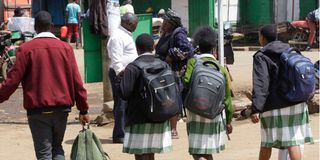Schools break for midterm as principals hold Mombasa summit

Students walk on the streets of Elburgon town in Nakuru County as they head home for the midterm break on June 21, 2025.
What you need to know:
- Delayed disbursement of capitation has forced some school heads to take bank loans to stay afloat.
- School heads argue that the situation worsened after the Kenya Kwanza administration took office in 2022.
Primary and secondary school learners will break for midterm this week as their principals converge in Mombasa for their annual conference.
Learners will take a five-day break starting June 25, 2025 and return to school on June 29, 2025. They will then have three more weeks to complete their syllabus and revise for their exams before closing for the August holiday, which will last three weeks.
They will return to school on August 25 for the busiest third term, an examination period during which candidates will sit the Kenya Primary School Education Assessment (KPSEA), Kenya Intermediate Level Education Assessment (KILEA), Kenya Junior School Education Assessment (KJSEA) and the Kenya Certificate of Secondary Education (KCSE).
The Kenya Secondary Schools Heads Association (Kessha) National Chairman Willie Mwangi Kuria said more than 9,000 principals will gather in Mombasa to deliberate on the theme ‘Embracing Pathways in Senior School’.
Currently, 1.2 million Grade 9 learners are selecting their preferred career pathways and subjects for senior school—an exercise that will last one month.
Under this year’s theme, the principals who will receive the Grade 9 learners in their institutions next year will discuss their expectations at the Sheikh Zayed Hall from June 22 to June 27, 2025.
This follows a directive from the Ministry of Education requiring 100 national schools to introduce day wings to accommodate day scholars and support 100 per cent transition. However, principals have opposed the move, arguing that mixing boarders and day scholars could be “dangerous.”
According to the programme, Ministry of Education officials led by Director General Dr Elyas Abdi will engage in an open forum with directors overseeing Senior School Education, Quality Assurance and Standards, Field Coordination and Co-curricular Activities, Project Coordination and Delivery, School Audit, Policy and Partnerships, and Special Needs Education.
Vice Chancellor of the Technical University of Mombasa and member of the Presidential Working Party on Education Reforms Prof Laila Abubakar will speak on leveraging innovation and technology in senior school education.
Auditor General Nancy Gathungu will address the issue of safeguarding school funds, while the Teachers Service Commission will discuss the implementation of pathways and the role of teachers and stakeholders.
Health Cabinet Secretary Aden Duale will speak on strengthening school health systems for a healthier nation and the role of school leadership in advancing the Social Health Authority.
The programme shows the National Treasury and Economic Planning Cabinet Secretary John Mbadi will explore the financing of senior school education and its sustainability.
Capitation remains a major challenge facing public schools. Education stakeholders have urged the government to increase allocations to cushion against inflation or allow school administrators to raise school fees.
In 2008, the late President Mwai Kibaki introduced the Free Day Secondary Education (FDSE) program, disbursing Sh22,244 per learner. These funds enabled schools to run smoothly.
However, the allocation was later reduced to Sh17,000 due to inflation, resulting in a Sh64 billion capitation debt accrued over the last four years. Principals have reported that some funds are being withheld by the government, leaving schools with huge debts owed to suppliers.
Delayed disbursement of capitation has forced some school heads to take bank loans to stay afloat. Principals, their associations, and unions argue that the situation worsened after the Kenya Kwanza administration took office in 2022.
Under the capitation formula, schools are supposed to receive 50 per cent (Sh11,122) in Term 1, 30 per cent (Sh6,673) in Term 2, and 20 per cent (Sh4,448) in Term 3.
“On paper, the capitation was Sh22,244, but the actual money that went to schools was less than that. So what we have done is factor in figures that the government can support because it is not right to tell a school or university that you will send so much money and then fail to disburse,” said President William Ruto during a media engagement at the Sagana State Lodge in Nyeri County in April.
The Head of State added that when he took office after the August 2022 general election, capitation was already set below the Sh22,244 benchmark.
Principals say there were Sh60 billion in unfunded students by the end of 2023.
School administrators continue to urge the Ministry of Education to address the financial gap to ensure smooth operations and support the well-being of millions of students across the country.


